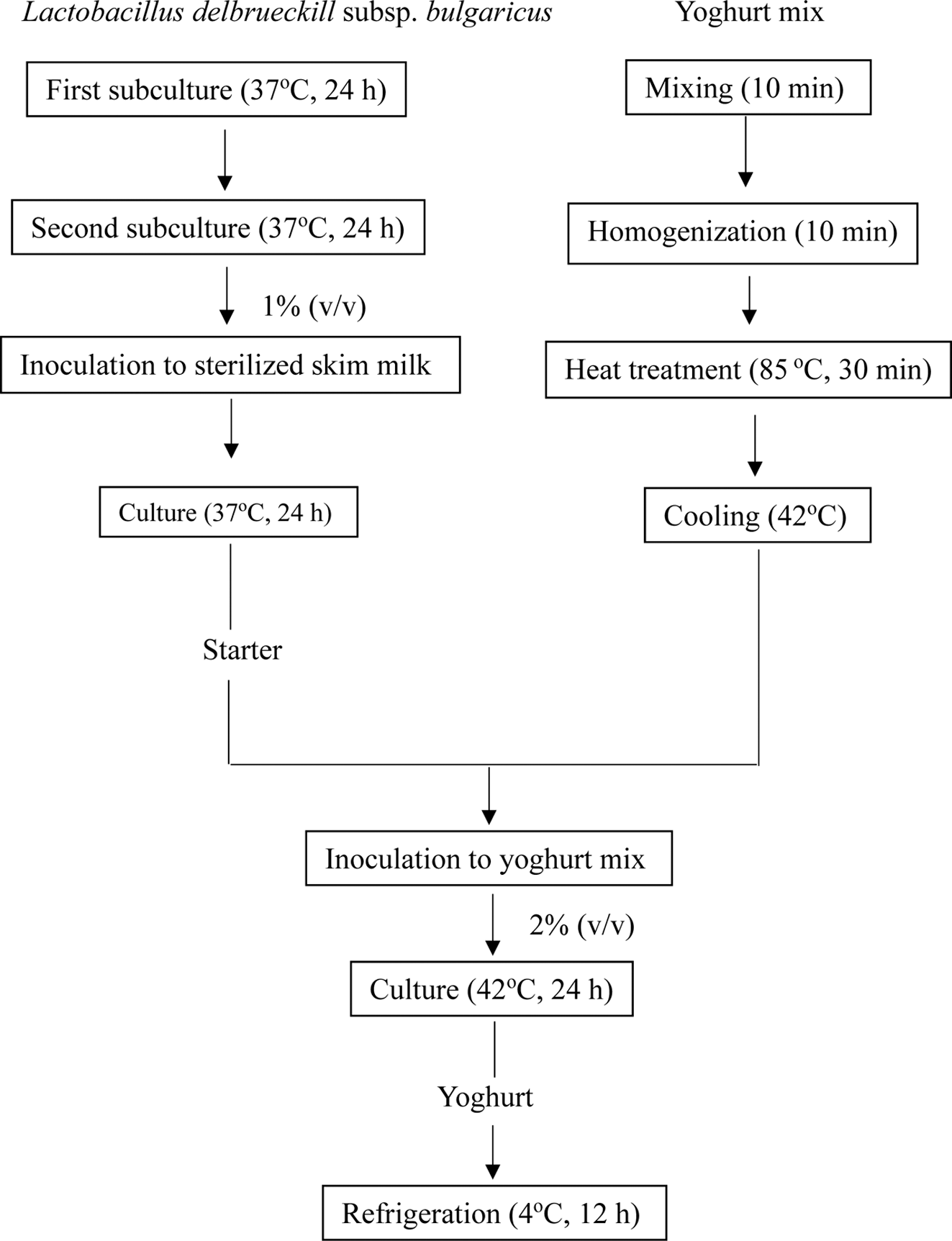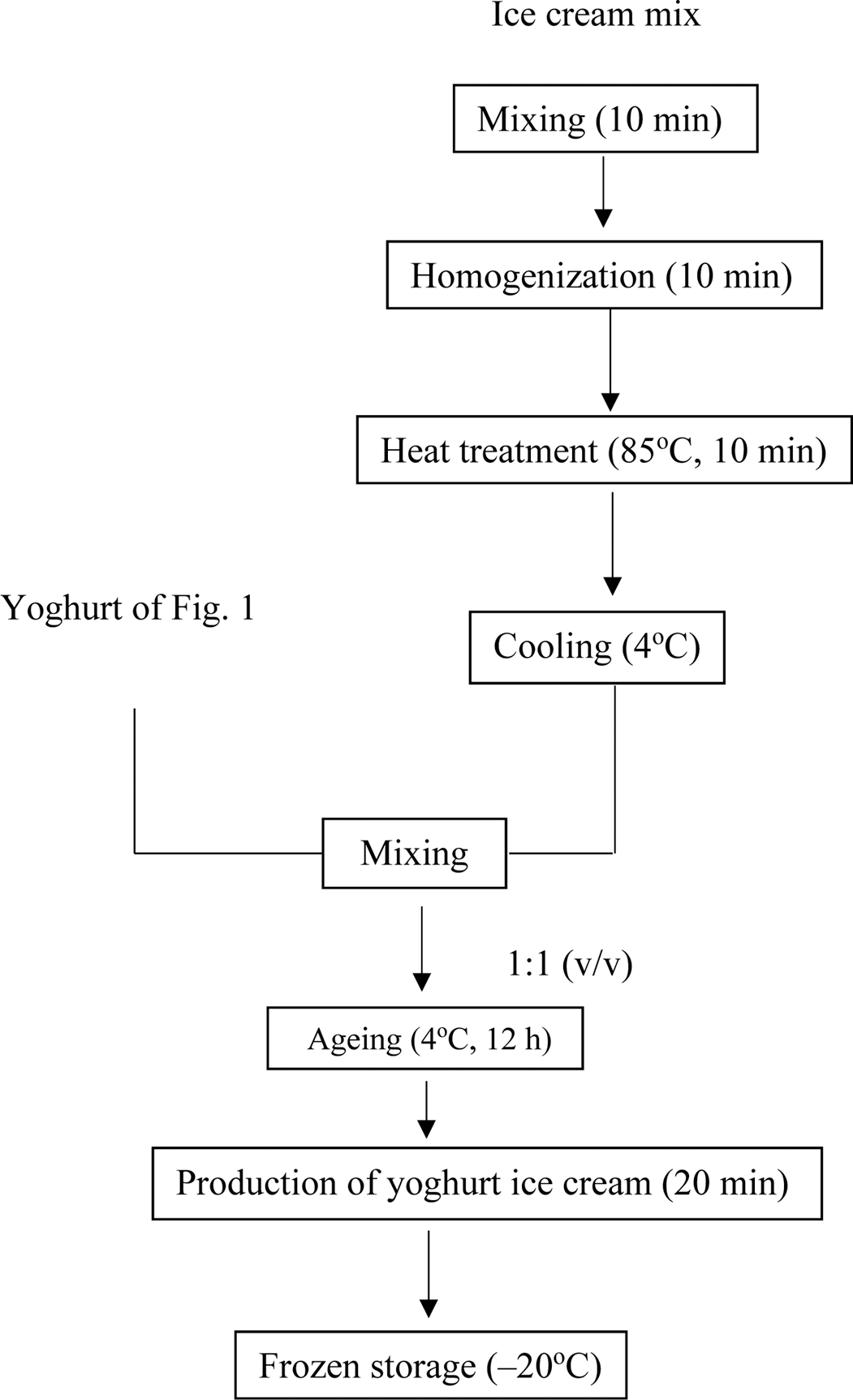서 론
포유류 젖을 유산균으로 발효시킨 요구르트(yoghurt)의 섭취는 수천 년 전부터 시작된 것으로 추정된다(Dunne et al., 2012). 유산균은 장내 유해물질 생성 억제, 혈중 콜레 스테롤 저하와 면역력 상승 등의 건강 증진 효과가 있다 (Kim et al., 1999; Bang & Jeong, 2007). 요구르트의 독특 한 풍미와 유익한 기능 때문에 인기를 누리고 있지만 냉장 유통과 짧은 유효 기간 등의 단점이 있다(Shen et al., 2005; Jiao, 2008).
유럽에서 15세기경 음료를 동결시켜 ice cream을 제조하 였으며 미국에서는 19세기쯤 산업적으로 공장에서 대량 생 산 시판하였고 한국에서는 1970년대부터 선보였다(Lee et al., 2000b; Kim et al., 2004). 아이스크림 recipe의 일반 적인 당분 함유량은 12-18%였다(Ruan, 2013). 식품의약품 안전처에서 실시한 한국 국민의 건강 영양 조사 결과를 보면, 2014년 국민의 하루 당분 섭취량은 평균 11.9 g으로 2010년 9.7 g에 비해 23% 늘어났다(Ministry of Health and Welfare, 2015). WHO (World Health Organization)는 하루 당분 섭취량이 전체 섭취 열량의 10%(즉 50 g)을 넘지 않 아야 한다고 권고하였고 최근에는 전체 열량의 5% (즉 25 g) 미만으로 기준을 강화하려고 한다(Park, 2015). 설탕 은 활동에 필요한 포도당을 공급해주는 에너지원이지만 곡 류, 과일 등을 통해 충분히 섭취할 수 있기 때문에 따로 먹지 않아도 된다. 설탕을 다량 섭취하면 소화력이나 칼슘 흡수력 저하와 체질 산성화로 저항력이 약화된다(Park, 2015).
요구르트 아이스크림(frozen yoghurt)은 1974년 Czechoslovakia에서 처음으로 생산되었으며, ice cream mix 개발 및 제품 기능성 등에 관한 다양한 연구가 진행되었다(Shin & Yoon, 1996). 두유(Jang, 2013), 낙타유(Al-Saleh et al., 2011), 유청분말(Shin et al., 1995), 쌀(Lee et al., 2000a) 등 을 첨가한 새로운 요구르트 아이스크림 제조도 시도되었다.
한국 쌀 생산량은 증가(Park & Kim, 2015)하였지만 연 간 1인당 쌀 소비량은 2013과 2014년 각각 67.2와 65.1 kg (Seo & Jeong, 2015) 그리고 2015년도에는 62.9 kg으로 꾸 준히 감소하고 있다(Park & Jeong, 2016). 세계무역기구 (WTO, World Trade Organization)에 가입 후 외국산 쌀을 2004년부터 의무적으로 수입하게 되어(Yun, 2007) 의무수 입 물량도 2014까지 증가하였다(Kim et al., 2014b; Kim et al., 2015a). 쌀 관세화가 실시된 2015년 이후에는 수입 량 감소가 예상되지만(Seo & Gang, 2015) 쌀 재고량은 매 년 증가하여 장기 보관에 따라 관리비용 증가와 고미화(古 米化)에 따른 품질 저하가 예상된다(Kim et al., 2015a). 팽 화미분은 쌀을 고온 고압에서 상온 상압으로 급격히 팽창 시킨 알파화 된 전분이다(Kim, 1991). 호화전분은 생전분 과 달리 조직이 불규칙하여 효소 작용이 쉬우며 당화가 잘 이루어진다(National Tax Service Technical Service Institute, 2005).
설탕 소비 감소와 쌀 소비를 촉진하기 위한 연구와 제품 개발이 필요한 실정이다. 본 연구에서는 설탕을 쌀가루 또 는 팽화미분으로 대체하여 제조한 요구르트의 pH, 산도, 점도, 유산균 수와 색도 그리고 요구르트를 원료로 만든 요구르트 아이스크림의 점도, 오버런, 녹아내리는 정도, pH, 유산균 수와 색도를 조사하였다.
재료 및 방법
탈지분유(Seoul Dairy Co-op, Yangju, Korea), 전지분유 (Seoul Dairy Co-op, Yangju, Korea), 휘핑크림(Seoul Dairy Co-op, Ansan, Korea), 설탕(Samyang Co., Ulsan, Korea), Gelatin (Edentown F&B Co., Incheon, Korea), 안정제 (Garunara Co., Seoul, Korea)는 시중에서 구입하였다. 국내 산 2008년 단립종 쌀가루는 태평양물산 주식회사(Ansan, Korea)에서 그리고 태국산 2012년 장립종 쌀가루는 개미산 업 주식회사(Eumsung, Korea)에서 구매하였고 국내산 2008년 단립종과 태국산 2012년 장립종 팽화미분은 점보 식품 주식회사(Hwasung, Korea)에서 얻었다
Autoclave (KAC-080, Kukje Engineering Co., Seoul, Korea)에서 살균(121°C, 15분)된 Lactobacilli MRS broth (Difco Laboratories, Detroit, MI, USA) 배지 9 mL를 auto pipette (Pipetman ClassicTM, Gilson, Inc., Sarcelles, France) 으로 test tube에 넣었다. 한국미생물보존센터(KCCM, Seoul, Korea)로부터 구매한 유산균 균주(Lactobacillus delbrueckii subsp. bulgaricus) 1 mL를 첨가하고 37°C incubator (Samhwa Scientific Co., Seoul, Korea)에서 24시간 계대 배양하였다. Clean bench (SCB1013-1300, Shinsaeng Co. Ltd., Seoul, Korea) 안에서 고압멸균된 10% (w/v) skim milk 배지(Difco Laboratories, Detroit, MI, USA)에 계대 배양된 유산균을 1% (v/v) 접종하고 37°C incubator 에서 24시간 저장하여 starter를 만들었다(Jung & Shin, 2005).
단립종 쌀가루, 단립종 팽화미분, 장립종 쌀가루 또는 장 립종 팽화미분으로 설탕을 대체 한 요구르트 mix 조성은 Table 1과 같다(Lee et al., 2000a). 믹스를 각각 10분 간 hot& stir (US/PC420, Corning Inc., NY, USA)로 교반하고 homogenizer (Ultra-Turrax T-25, IKA-WERKE GMBH&Co. KG., Staufen, Germany)로 균질화시키고 85°C water bath (BW-30G, Jeiotech, Daejeon, Korea)에서 30분 간 살균 후 42°C로 냉각시켰다. Starter 2% (v/v)를 요구르트 mix에 접 종하여 42°C incubator에서 24시간 배양하여 요구르트를 만든 후 5°C에서 12시간 냉각시켰다(Fig. 1).
단립종 쌀가루, 단립종 팽화미분, 장립종 쌀가루 또는 장립종 팽화미분으로 설당을 대체 한 아이스크림 mix의 성분은 Table 2와 같다(Shin et al., 1995). 시료를 각각 10분 간 교반 및 균질화하고 85°C water bath에서 10분 간 열처리한 후 4°C로 냉각시켰다. 제조된 요구르트와 아 이스크림 믹스를 1:1 (v/v)로 혼합하고 4°C에서 12시간 숙성하였다. 숙성된 믹스를 아이스크림 제조기 (MDI-502, Macdous, Bucheon, Korea) 냉각용기에 넣고 20분간 작동 시켜 요구르트 아이스크림을 만들고 -20°C에 보관하였다 (Fig. 2).
요구르트 또는 녹인 아이스크림을 삼각플라스크에 넣고 pH meter (420A, Thermo Orion Inc., Beverly, MA. USA) 로 측정하였다(Lee, 1993).
요구르트 10 g을 메스플라스크(100 mL)에 넣고 정제수 40 mL를 첨가하였다. 희석된 요구르트에 1% (v/v) phenol (Daejung Chemicals & Metals Co., Ltd., Siheung, Korea) 용액 0.5 mL를 가하고 burette의 0.1 N NaOH (Samchun Pure Chemical Co., Ltd., Pyeongtaek, Korea)로 적정하였 다. Burette에서 떨어진 0.1 N NaOH에 의해 희석된 시료 가 미색(米色)에서 선홍색을 띄게 된 후 30초 이상 유지될 때까지 소비된 0.1 N NaOH 양을 측정하였다. 소비된 0.1 N NaOH 양을 다음 식에 대입하여 젖산(%)으로 산도 를 계산하였다(Kim et al., 1993; Mun, 2003).
요구르트나 아이스크림을 비커에 담은 후 Brookfield viscometer (DV 2T Viscometer, Brookfield Engineering Laboratories INC., Middleboro, MA, USA)를 이용하여 측 정하였다. Brookfield viscometer torque 값이 70-80% 나오 도록 spindle 64와 60 rpm (revolutions per minute)으로 설 정하였다. 안정된 점도 값이 나오도록 1분 간 spindle을 회 전시킨 뒤 12초 간격으로 측정한 값을 cp (centipoise)로 나타냈다(Park, 2002).
요구르트 유산균 수 측정은 Lactobacilli MRS agar (Difco Laboratories, Detroit, MI, USA)배지를 이용한 표준평판배 양법으로 계수하였다(Richardson, 1985). Clean bench에서 멸균된 0.1% peptone (Daejung Chemicals & Metals Co., Ltd., Siheung, Korea) 용액 9 mL에 요구르트 1 mL를 첨가 하고 minishaker (JF/MS-1, IKA Works (Asia) Sdn. Bhd., Malaysia)로 혼합하고 연속 희석하였다. Petri dish에 희석 액 1 mL와 45°C Lactobacilli MRS agar 배지 약 15 mL 를 붓고 잘 섞이도록 회전한 후 실온에서 굳혔다. 배지가 굳은 뒤 다시 Lactobacilli MRS agar 배지 5 mL를 붓고 실온에서 굳혔다. 배지가 굳으면 petri dish 뚜껑을 닫고 뒤집은 상태로 37°C incubator에서 24시간 배양하였다. 배 양 후 CFU (colony forming unit)가 30-300개 형성된 petri dish를 선택하여 log CFU/mL로 표시하였다(Park et al., 2008).
표준색판(X=94.30, Y=96.11, Z=114.55)으로 보정 후 원 형 cell에 담긴 요구르트나 아이스크림을 Chromameter (CR- 400, Konica Minolta Sensing, Inc., Tokyo, Japan)로 측정 하였다. 밝은 정도(lightness)를 나타내는 L값, 적색도 (redness)를 나타내는 a값 그리고 황색도(yellowness)를 나 타내는 b값으로 표시하였다(Kim et al., 2004).
숙성된 믹스와 아이스크림을 scooper (H3304-40, Nikken, Tokyo, Japan)로 떠서 무게를 측정하고 다음과 같은 공식으 로 over-run (%)을 구하였다(Martinou-Voulasiki & Zerfiridis, 1990).
Scooper로 뜬 아이스크림을 비커 위 간격 5 mm 철망 위 에 놓았다. 녹지 않은 무게와 상온에서 30분 간 녹은 시료 무게를 구한 후 아래 식에 대입하여 melting-down (%)을 얻었다(Shin & Yoon, 1996).
아이스크림 유산균 수의 측정은 BCP plate count agar (Eiken Chemical Co., Ltd., Nogi machi, Japan)배지를 이 용한 표준평판배양법으로 계수하였다(Richardson, 1985). 요구르트 유산균 수 측정과 동일한 방법으로 실시하였지만 배지가 굳으면 45°C incubator에서 24시간 배양 후 log CFU/mL로 나타냈다(Shin et al., 1995).
결과 및 고찰
요구르트 pH는 발효 진행 상황, 성분 변화 및 산미 정 도를 알 수 있는 중요한 품질 지표이다(Yang et al., 2010). 설탕 대신 단립종 쌀가루, 단립종 팽화미분, 장립종 쌀가 루, 장립종 팽화미분으로 제조한 요구르트의 pH는 Table 3 과 같다. 설탕을 제외한 시료는 3.91-4.49로 시판 제품 범 위 3.27-4.59 안에 들었다(Kim et al., 2013). 설탕은 4.93 으로 다른 시료보다 높았다. 동일 곡종에서 쌀가루가 팽 화미분보다 높거나 같았다(p<0.05). 팽화에 따른 규칙적인 조직 파괴와 당화 때문에 유산균이 활성화된 것으로 여겨 진다(Kim et al., 2014a). 동일 처리구에서는 단립종이 장 립종보다 높았다. 장립종과 단립종의 아밀로즈 함량은 각 각 28% (Choi & Shin, 2009)와 20% (Korean Society of Food Science & Technology, 2008)였다. 아밀로즈 함량이 높으면 팽창 용적과 용출 고향물량이 증가하기(Etuko et al., 1995) 때문에 산 생성 능력이 높아진 것으로 여겨지며 Dong & Yi (2011)의 보고와 유사하였다.
발효가 진행되면 젖산균 등의 작용으로 각종 유기산이 생산되기 때문에 산도가 증가한다(Lee et al., 1996). 산도 도 pH와 부합하여 설탕은 다른 시료보다 낮았다. 동일 곡 종에서 쌀가루가 팽화미분보다 그리고 동일 처리구에서 단 립종이 장립종보다 낮은 것으로 나타나(p<0.05) Han et al. (2000)의 연구와 일치하였다. 설탕과 단립종 쌀가루는 시판 요구르트 범위 0.72-1.40% (Kim et al., 2013) 안에 있지만 단립종 팽화미분과 장립종은 1.46-1.75%로 더 높았다.
요구르트 점도는 요구르트 혼합액의 총고형분, 사용균주 의 점액 생산능력 등 다양한 원인에 의하여 영향을 받는다 (Rasic & Kurmann, 1978). 동일 곡종에서는 팽화미분이 높아 Ye (2009)의 보고와 같이 팽화미분의 높은 호화 능력 에 기인한 것으로 여겨진다. 단립종의 높은 아밀로펙틴 함 량(Korean Society of Food Science & Technology, 2008; Kim et al., 2014)과 중합도(Tester et al., 2004) 때문에 동 일 처리구에서는 단립종이 장립종보다 크게 나타났다(p< 0.05).
건강 증진 효과가 있은 유산균의 수는 모든 시료에서 8.19-8.91 log CFU/mL로 발효유 가공기준 및 성분 규격, 8 이상(Kim et al., 1993)을 만족시켰다. 산을 제일 많이 생산한 장립종 다른 시료보다 높았다(p<0.05).
색도는 요구르트의 선택과 품질에 큰 영향을 미친다 (Han, 2005). 요구르트 색도는 Table 4와 같이 동일 곡종에 서 고온 및 고압의 팽화 공정 때문에 팽화미분 L과 a값이 낮아 Dong & Yi (2011)의 결과와 유사하였다. 장립종보다 4년 긴 저장기간 때문에 단립종 L값이 낮게 나타난 것 (p<0.05)으로 여겨진다.
요구르트 pH처럼 동일 곡종에서 쌀가루가 팽화미분과 같거나 높았고 단립종이 높았다(p<0.05).
아이스크림 점도는 제품 형태와 부드러운 질감 등에 영 향을 끼친다(Arbuckle, 1986). 설당 대신 단립종 쌀가루, 단립종 팽화미분, 장립종 쌀가루, 장립종 팽화미분으로 제 조한 아이스크림의 점도(Table 5)는 요구르트 점도와 같이 동일 곡종에서 팽화미분이 쌀보다 높았으며, 동일 처리구 에서 단립종이 장립종보다 높았다(p<0.05).
장립종이 다른 시료보다 높게 나타나(p<0.05) 요구르트 유산균수와 같은 경향을 보였다.
아이스크림 제조 중 공기를 혼입하여 부피가 늘어나고 중량은 감소하게 된다(Han 2005). Over-run은 아이스크 림의 조직감 등 품질 특성을 평가하는 중요 요소 중 하 나이다(Lee et al., 2000b). 점도와 보수력이 클수록 자유 수 함량은 떨어지고 공기량은 증가하기(Kwon & Lee, 2002) 때문에 아이스크림 over-run도 점도가 높은 팽화미 분과 단립종이 높아(p<0.05) Park (2002)의 보고와 유사 하였다.
단열재로 작용하는 공기 함량이 높을수록 열전도가 늦어 진다는 Sofjan & Hartel (2003)의 보고와 같이 over-run이 높은 시료에서 낮은 melting-down 관찰됐다. Over-run이 큰 팽화미분 그리고 단립종의 melting-down이 낮게 나타났 다(p<0.05).
아이스크림의 색도(Table 6)는 요구르트 색도처럼 팽화미 분 L과 a값이 그리고 단립종 L값이 낮았다(p<0.05).
요 약
설탕을 쌀가루 또는 팽화미분으로 대체하여 제조한 요구 르트의 pH, 산도, 점도, 유산균 수와 색도 그리고 요구르 트를 원료로 만든 요구르트 아이스크림의 점도, over-run (오버런), melting-down (녹아내리는 정도), pH, 유산균 수 와 색도를 조사하였다. 설탕 요구르트와 설탕 요구르트 아 이스크림의 pH는 다른 시료보다 높았고 동일 곡종에서 쌀 가루가 팽화미분과 같거나 높았고 동일 처리구에서 단립종 이 장립종보다 높았다. 요구르트 산도는 pH와 부합하여 동 일 곡종에서 쌀가루가 팽화미분보다 그리고 동일 처리구에 서 단립종이 장립종보다 낮았다. 요구르트 점도 그리고 아 이스크림 점도 및 over-run은 동일 곡종에서는 호화도가 큰 팽화미분이 높았고 동일 처리구에서는 아밀로펙틴 함량 은 높은 단립종이 장립종보다 크게 나타났다. 요구르트와 아이스크림 유산균 수는 장립종이 다른 시료보다 높았다. 요구르트와 아이스크림 색도는 동일 곡종에서 고온 및 고 압을 거친 팽화미분 L과 a값이 낮았고 저장 기간이 긴 단 립종 L값도 낮게 나타났다. 단열재로 작용하는 공기 때문 에 over-run이 큰 시료에서 melting-down은 낮은 값을 보 였다(p<0.05). 설탕을 쌀가루 또는 팽화미분으로 대체한 요구르트와 요구르트 아이스크림의 제조 가능성을 보여 주었다.

